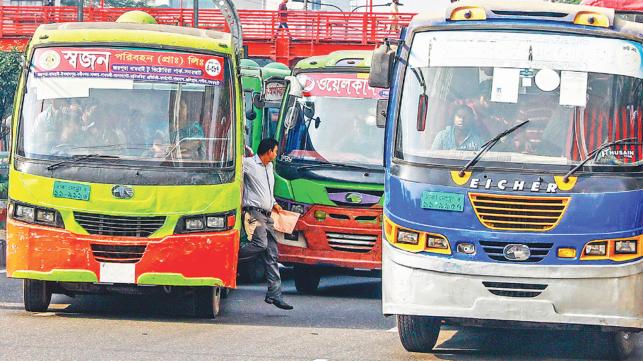Anarchy on the roads
Lack of lights on the streets, plying of unfit vehicles, careless mentality of the drivers, and passengers’ suffering caused by transport owners and workers are still the same as before.
Several government agencies after the protest sparked by the deaths of two college students on 29 July said that they had taken a number of initiatives and promises and termed the protest an ‘eye opener’ for them.
But the ‘eye opener’ could not control the number of deaths in road accidents.
According to Nirapad Sarak Chai (NISCHA), a total of 213 people were killed in 277 road crashes in July last. The number rose to 300 in 361 accidents in August while it was 309 in 286 accidents in September.
Amid this reality, National Road Safety Day was observed across the country on Monday.
Road safety campaigner and NISCHA chairman Ilias Kanchan told Prothom Alo that every one including drivers, pedestrians, transport owners and even influential people obeyed traffic rules as they were in danger during the protest.
“As their danger is over, they have again started violating traffic rules,” added Kanchan, once a popular film star.
Talking about transport owners and workers’ mentality, Ilias Kanchan said, they protest against the laws as they know their vehicles and drivers are not okay.
“They take to the streets when the issue of road safety is raised,” he added.
Osman Ali, general secretary of Bangladesh Sarak Paribahan Sramik Federation, told Prothom Alo that they had boycotted all programmes of National Road Safety Day.
Rather, they would organise a rally in front of National Press Club to protest against some sections of Road Transport Act on 27 October and observe a countywide strike on 28-29 October.
After around a one-week protest of students in August, Prime Minister’s Office (PMO) issued at least 30 directives asking the authorities concerned to take measures, including keeping additional drivers in long-distance buses and building rest rooms for drivers beside highways.
To implement these measures, shipping minister Shajahan Khan and home minister Asaduzzaman Khan were directed to conduct meetings from time-to-time. But, no meeting has been held in this regard.
After the protests demanding safe roads, the passage of the road transport act is the major development. Other measures are limited to circulating brochures for raising awareness, filing cases and fines, and organising short-term training for them.
A 10-member probe body, led by an additional secretary of the Road Transport and Highways Division was formed to look into a Natore road crash that killed 15 people.
According to its report, the highway had no signal and sign and the driver of the human hauler had no license.
On 23 September, planning minister AHM Mustafa Kamal told a seminar, “When you leave Dhaka, you can’t understand whether you are heading for Chattogram or Sylhet or returning back in the capital (for lack of signs).”
According to BRTA, around 3.5 million vehicles ply across the country and the number of drivers who have licence are 1.9 million. So, some 1.6 million vehicles are being run by drivers who have no licence.
Professor Kazi Saifun Newaz of Accident Research Institute (ARI), Bangladesh University of Engineering and Technology (BUET) told Prothom Alo, “There are many errors in the ownership and plying of public transports. There is also lack of signs and signals while pedestrians are not conscious, making a total mess for road transport.”
“Its remedy can’t come in a weeklong or month-long programme. Continuous efforts and endeavours are required for this,” he added.
*This report, originally published in Prothom Alo print edition, has been rewritten in English by Imam Hossain.

